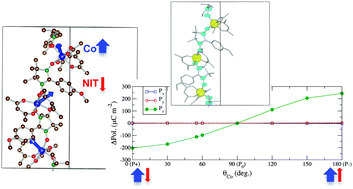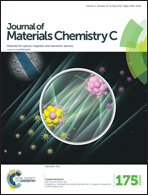Magnetoelectric coupling and spin-induced electrical polarization in metal–organic magnetic chains
Abstract
We explore by density functional calculations the possible variation of a magnetically induced electric polarization in the prototypical single-chain magnet CoPhOMe and related MnPhOMe, underlying a sizable magnetoelectric interaction with appealing perspectives in cross-coupled control of their magnetic and electric properties. We find that going from ferrimagnetic to ferromagnetic hypothetical configurations gives rise to a non-negligible electric polarization along the helices axis, estimated up to 0.100 μC cm−2 and 0.065 μC cm−2 for the Co- and Mn-based chains, respectively. Our analysis sheds light on the microscopic nature of the spin-induced electric polarization, showing that the dominant contribution is an isotropic exchange-driven mechanism, modulated by the relative alignment of the spin pairs between the 3d-ions and the neighboring radicals. Moreover, we quantified the variation of the local electric dipoles produced by the local switching of the magnetic bondings along the chains, providing insight on the dipoles that may develop at the domain walls of the magnetic systems. Our theoretical prediction of spin-induced polarization and magnetoelectric coupling in metal–organic magnetic helices opens up interesting perspectives such as the modulation of their magnetization dynamics via electric fields.

- This article is part of the themed collection: Celebrating our 2019 Prize and Award winners

 Please wait while we load your content...
Please wait while we load your content...